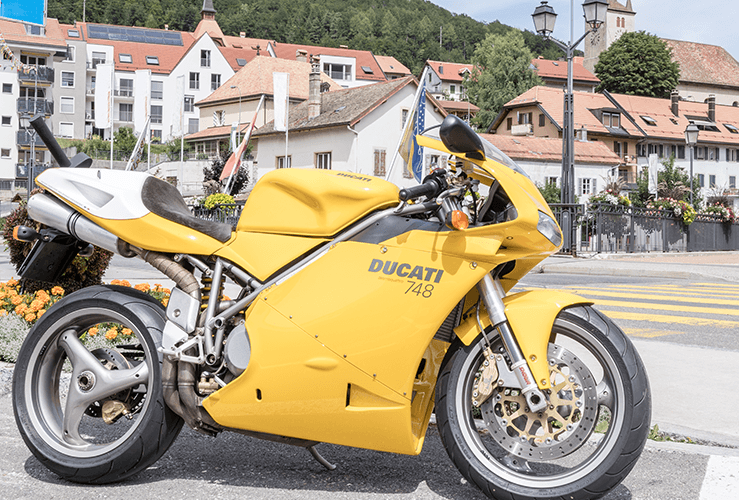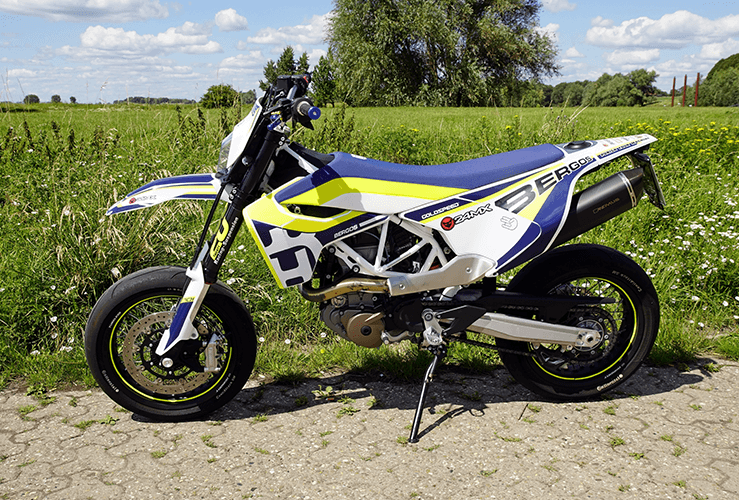If you're new to motorcycles, you may be wondering what the difference is between a single and a twin cylinder machine. If so, read on.
Single cylinder engines
As the name suggests, a single cylinder engine contains one cylinder and one piston. These engines are inexpensive to produce, lightweight, and mechanically simple. They deliver hefty low-end torque, making them excellent for spirited low-speed riding on back roads or trails.
On the downside, a single cylinder motorcycle engine tends to generate more vibration, especially as the revs rise. At higher RPMs they can feel strained and a little slow compared with multi-cylinder alternatives.
For general upkeep, singles are often easier for beginners to service. For basic tips, you may find guides such as How to Check Your Chain Tension or Simple Home Motorcycle Maintenance Tasks useful.
Twin cylinder engines
A twin cylinder engine features two cylinders and two pistons. Because the pistons counterbalance one another, vibration is reduced and overall refinement improves. These engines generally rev higher, producing more power and offering smoother acceleration than singles.
Twins may not always match the thumping low-end torque of a single, but they strike an excellent balance between usable power, smoothness, and everyday comfort.
Why are some engines multi-cylinder?
Multi-cylinder engines - including twins - are designed for a particular demographic that wants smoother power delivery and less noise. Multicylinders offer better performance and equipment for longer rides. Most riders wouldn’t want to attempt the Boscastle to Land's End run in a single cylinder, chiefly because of the discomfort and noise.

V-Twins
Among the twin engines available, the V-twin is perhaps the best-known and best-loved. Its V-shaped formation results in a smoother, more powerful motor and ride.
Twins are more complex and therefore more costly to produce. They are also more expensive to repair compared to single cylinder motorcycles.
Parallel twins
As the name suggests, this twin cylinder set-up has the pistons moving in parallel. With 360 degree twins, the cylinders can go up and down together, while 180 degree twins see the pistons move in opposite directions (one up, one down etc).
Parallels have issues with vibration, but can deliver a similar power profile to a V-twin - while costing less to manufacture.
Boxer twins
Boxer twins have each piston moving in and out (left and fight) at the same time, mirroring one another's movement. They each have their own crankshaft, unlike a regular V-twin. It is so-named because it resembles a boxer beating their chest.
Since the cylinders stick out, cooling is easier - but the extra width does affect ground clearance. Because of their bulbous shape, boxer engines are more liable to sustain damage off-road or filtering through traffic.
4 cylinder vs 2 cylinder motorcycles
Generally, the more cylinders on a bike, the more power it produces and the smoother it runs - so a four cylinder delivers more power than a two cylinder. Splitting the displacement into four small cylinders enables the engine to spin quicker, which means it can process more air and fuel, resulting in more power.
With that in mind, four cylinder engines are put to best use in sport bikes, while two cylinders are suited to all-round and off-road bikes.
Four cylinder bikes dominate MotoGP races thanks to their (generally) superior power.
That said, two cylinder engines can be placed lower down, which can improve handling, while four cylinders must be placed higher up, which is detrimental to handling.
3 cylinder vs 2 cylinder motorcycles
As you might have guessed, three cylinders have three pistons, which makes for a smoother, quieter ride, and more power. They offer better balance than a four cylinder, while offering the same level of reliability (assuming build quality and materials are equal).

Best single cylinder motorbike?
Brands continue to invest in single cylinders, offering fresh options even as multi-cylinder bikes grow in popularity.
Husqvarna 701 Svartpilen – Noted for its sharp handling, potent KTM-derived motor, and minimalist Scandinavian design. Ideal for quick B-road blasts while keeping pace with multi-cylinder peers.
CCM Spitfire – Built around a BMW-designed, Husqvarna-produced engine, delivering 55 bhp and strong torque. Its British craftsmanship and limited-run appeal remain major draws.
Beta Alp 4.0 (2025 update) – A lightweight, mountain-goat-like trail bike with rugged reliability and ease of use for technical terrain.
Fantic Caballero 500 Scrambler – Retro styling meets off-road heritage, available in 125, 250 and 500 cc variants. Zongshen engines continue to offer dependable performance in 2025 models.
What motorcycle is best for beginners?
For new riders, the best option combines manageable power, predictable handling, and low running costs. Many learners benefit from a 300–500 cc single or twin cylinder machine because they are light, forgiving, and economical. A small to mid-capacity motorbike engine also keeps insurance and maintenance costs down while offering plenty of performance for real-world riding. Popular 2025 entry-level models include lightweight naked bikes, small adventure machines, and approachable commuters with modern rider aids.
Top 10 motorcycle engines
The “best” engines depend on the bike’s purpose, but several layouts and models stand out for reliability, performance, and innovation in 2025:
- Modern 1000 cc inline-four superbike engines
- 890–990 cc parallel twins
- 1200–1300 cc V-twins
- 675–800 cc triples
- Large-capacity boxer twins
- High-performance 450 cc singles
- Smooth 650–700 cc twins
- 200–300 cc learner-friendly singles
- 500 cc mid-range twins
- Electric motorcycle power units (rapidly improving in 2025)
Each design meets different needs, from race-ready powerplants to rugged commuter engines.
Maintenance and cost comparison
Singles are the simplest and cheapest to maintain. With fewer moving parts, servicing is usually quicker, valve adjustments are easier, and replacement components cost less. For riders on a budget, a single cylinder motorbike engine is the most economical long-term choice.
Twin cylinder engines, while more refined, involve more complexity. Valve checks take longer, components are pricier, and labour costs rise accordingly. However, many modern twins are durable and require less frequent major servicing.
In 2025, overall ownership costs remain noticeably higher for twins, but they offer better long-distance comfort and stronger performance, which many riders consider worth the premium.
Ready to ride smarter?
If you’d like to keep your bike running smoothly, our guides on Essential Pre-Ride Checks and How to Look After Your Motorcycle Battery may help.
Explore our full range of motorcycle guides, maintenance tips, and buying advice to get the most out of your machine.




